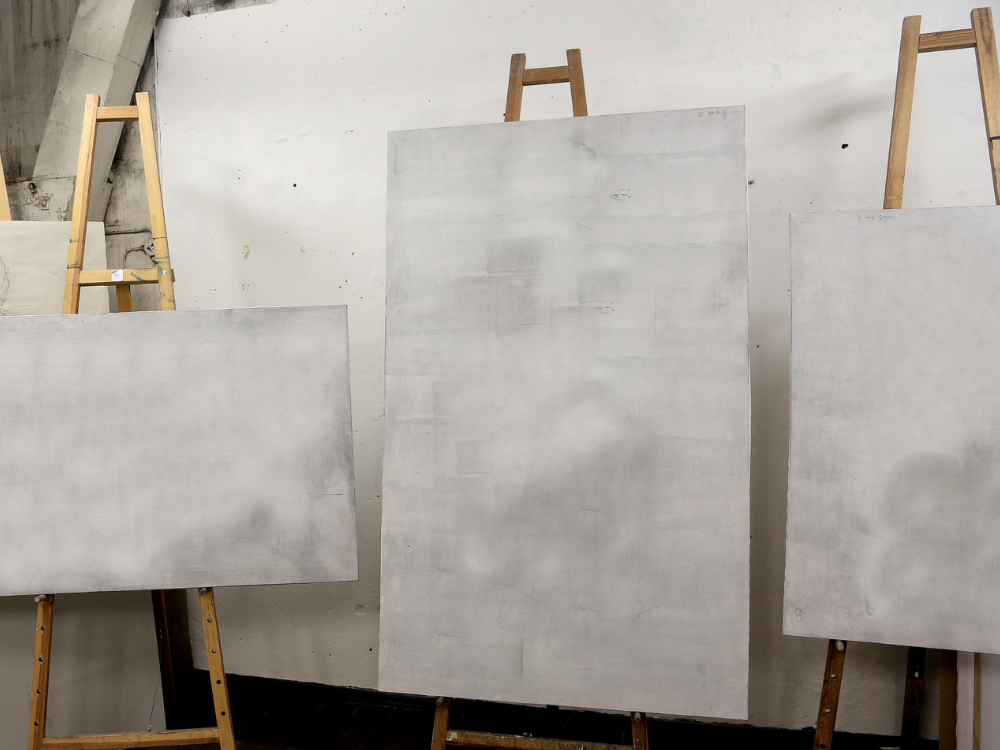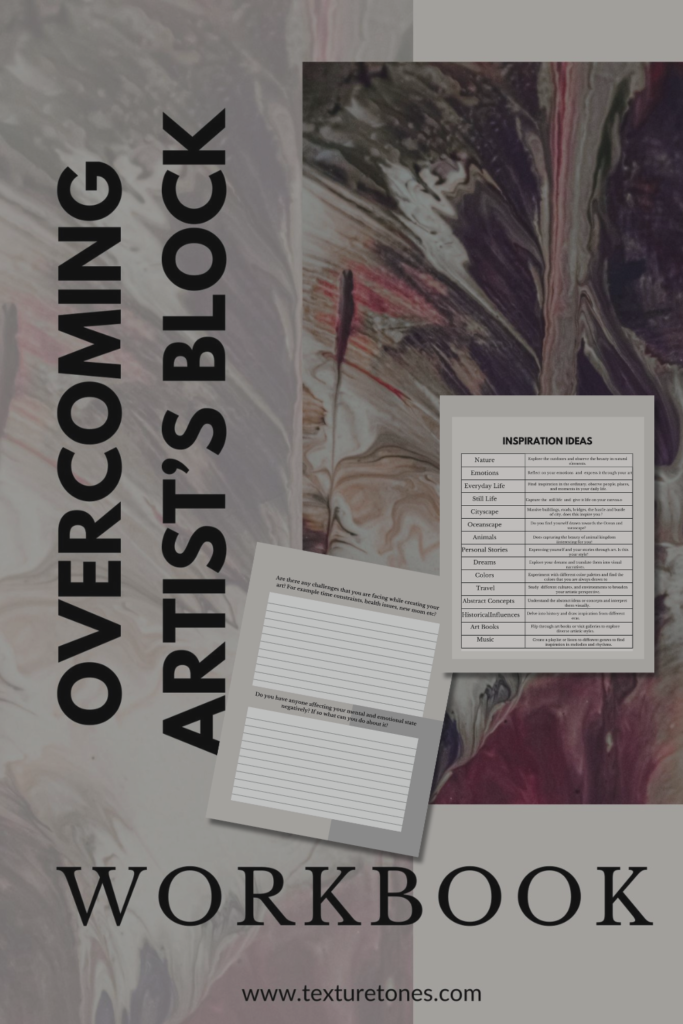
What is Artist’s Block or Creative Block?
Every artist in this world, no matter how experienced or inexperienced has encountered the formidable foe known as artist’s block.
It’s that haunting moment when your creativity hits a roadblock, your mind is blank and the canvas stares back at you and you have no idea what to do next.
Believe me you’re not alone in this struggle.
What causes creative block?
Here are some common reasons why artists may experience creative block
- Self-Doubt
There is nothing worse than self-doubt. You could create a masterpiece and yet keep pulling down yourself on your skills, ideas or even worthiness of your creation .
- Fear of Failure
The fear of not meeting personal or external expectations can be paralyzing. We keep scrolling through instagram feeds and pinterest and realize we are far from the standards of others.
- Perfectionism
Striving for perfection in every detail can lead to creative paralysis. The constant pursuit of flawlessness may prevent you from moving forward with your work.Its a never ending process where we could just sit with that small detailing which could take up several days of your week.
- Burnout
Most people do not realize the hours they spend working . This exhaustion and burnout, often caused by overworking or neglecting self-care, can deplete creative energy. This physical and mental fatigue can result in a lack of inspiration.
- Lack of Inspiration
External factors such as a monotonous routine, a stagnant environment, or a lack of exposure to new ideas can contribute to a dearth of inspiration, making it challenging for artists to create.
- Personal Challenges
Life throws us many challenges. Life events, emotional distress, or personal challenges can take a toll on an artist’s mental and emotional well-being, affecting their ability to engage in the creative process.
- Overthinking
Overanalyzing or overthinking the creative process can lead to a mental block. Most of us may get stuck in a loop of indecision, unable to move forward with our work.
- External Pressures
Pressure from deadlines, expectations from others, or financial concerns can create stress and anxiety, impeding the free flow of creative ideas.
- Comparisons
Constantly comparing one’s work to that of others can lead to feelings of inadequacy. This comparison trap may hinder creativity as artists strive to meet perceived standards.
- Routine and Repetition
Engaging in the same artistic routine or creating similar works repetitively can result in boredom and a lack of enthusiasm, contributing to creative stagnation.
Even the masters had gone through this block, and not only did they overcome it, but they also used it as a stepping stone to greatness.
Let us see few examples here.
Vincent van Gogh
One of the most celebrated artists in history, Vincent van Gogh, experienced bouts of intense artist’s block.
“The Starry Night” – the masterpiece, that was painted in 1889 during a stay at the Saint-Paul-de-Mausole asylum in Saint-Rémy-de-Provence, France, is a testament to the transformative power of creative perseverance.
In a letter to his brother Theo, Van Gogh described the painting as a reflection of the tumult within his own psyche, where the swirling stars and vibrant night sky mirrored the chaotic yet mesmerizing nature of his thoughts.
Van Gogh’s story teaches us profound lessons about the nature of artistic struggle.
The periods of creative stagnation were marked by self-doubt and mental turmoil. Yet, amidst the darkness, masterpieces like “The Starry Night” were born.
Leonardo da Vinci
The genius of the Renaissance, Leonardo da Vinci, faced moments of artistic paralysis.
His notebooks are filled with sketches and ideas that are left incomplete, even though there isn’t much historical evidence to suggest that Leonardo da Vinci experienced what we commonly refer to as “artist’s block” in the modern sense. However, these unfinished works could be seen as indicators of the artist’s struggle to bring certain ideas to fruition.
The famous “Adoration of the Magi” is an example of a painting that Leonardo left incomplete. This unfinished state has led art historians to speculate about the possible reasons behind its abandonment. Is it his pursuit for perfectionism? Or is it external circumstances? We do not know the exact reason, though several people claim different reasons.
Leonardo’s was both a master artist and scientist which could have added another layer of complexity to his creative process. Balancing these two pursuits may have presented him with unique challenges and moments of indecision, possibly contributing to what we might interpret as artist’s block. However, he created some of the most influential works in art history, including the Mona Lisa and The Last Supper.
Pablo Picasso
Pablo Picasso, the revolutionary artist who co-founded the Cubist movement and reshaped the art world, encountered periods of artistic stagnation.
In the early 1900s, Picasso went through a notable transition from his melancholic Blue Period to the warmer ,joyful and more optimistic Rose Period.
However, rather than succumbing to the block, Picasso used it as a catalyst for innovation. This period of uncertainty led to the creation of groundbreaking works that marked the inception of Cubism, a revolutionary art movement that shattered traditional perspectives and redefined the visual language.
One of Picasso’s most celebrated works, “Guernica,” emerged later in response to the chaos and devastation of the Spanish Civil War.
Picasso’s experience reminds us that even artistic giants encounter challenges. When he felt stuck creatively, he turned it into something amazing.
His artist journey teaches us that facing creative blocks head-on, rather than avoiding them, can lead to some of the most transformative and influential moments in their artistic journey.
Now that we got a glimpse on how great masters handled the mental turmoil they went through, let us see what can be done to overcome this.
Overcoming the Block: What can be done?
1. Reflect and Re-assess
Artist’s block often signals a need for reflection. Take a step back, reassess your creative goals, and consider what aspects of your art bring you the most joy. Use this pause to gain insights that can propel you forward.
2. Experiment and Play
Creativity thrives on diversity. Break away from your usual routine and experiment with new mediums, techniques, or subjects. As a creative, you need not be stuck on to one style or one medium. Many of the masters had multiple skills and talents. Personally Im completely against asking artists to niche down to just one thing. We dont need to be so hard on ourselves. There is nothing wrong in experimenting and trying out new styles, mediums or subjects. This is perfect for those who get bored very easily on just one monotonous style.
3. Connect with Fellow Creatives
Simply immerse yourself in the work of artists you admire. Sometimes, a fresh perspective is all you need to kickstart your own creative engine. Look at different works and see what interests you and try to replicate that in your own new version.
4. Embrace Imperfection
Perfectionism is the enemy of creativity. Understand that not every stroke has to be a masterpiece. Allow yourself the freedom to create imperfectly. Noone is here to judge you. No one is perfect. Each of us have our own struggles, our own weaknesses. All you need to do is create and create . Gradually you will see your work evolve into a masterpiece.
5. Establish a Ritual
Build a routine where you can sit peacefully, all by yourself without any distraction. That includes even phone calls from your close friends. Just be with yourself. Listen to some soft music if it helps you or a podcast that boosts your self confidence.Whether it’s a particular playlist, a cup of tea, or a specific workspace, establish rituals that immerse you in a creative mindset.
6. Draw Inspiration from Art History
Explore the works and stories of artists who confronted and conquered artist’s block. Their journeys can offer insights, encouragement, and a reminder that every creative struggle is a passage to something greater.
Conclusion: Embrace the Journey
Artist’s block is not a dead-end; The great artists of history faced similar challenges but emerged and they used this block as a way to evolve themselves to something even greater.
So, the next time you find yourself staring at a blank canvas, remember that this moment of pause is just a precursor to the masterpiece waiting to be unveiled.
Embrace the journey, for in overcoming artist’s block, you discover not only the depth of your creativity but the resilience of your artistic spirit.
If you require further assistance, feel free to download my FREE workbook for additional support, helping you achieve greater clarity and understanding.

